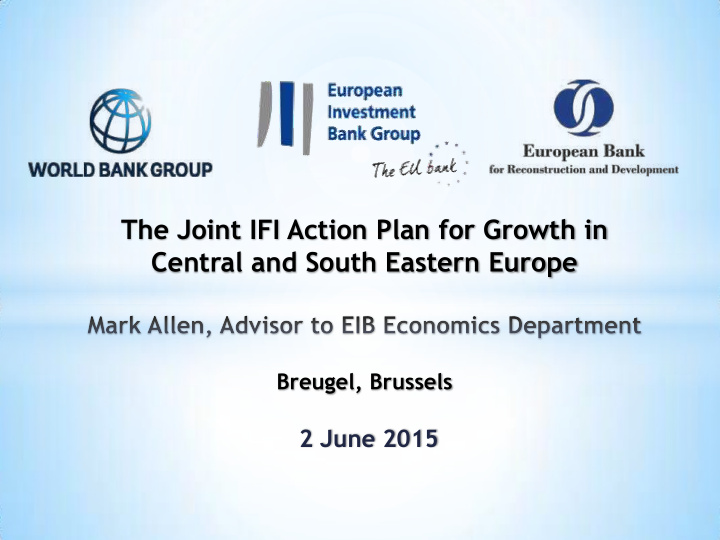



The Joint IFI Action Plan for Growth in Central and South Eastern Europe Breugel, Brussels 2 June 2015
* Launched in November 2012 by Presidents of the EBRD, EIB Group and World Bank Group * Response to concern about drying up of capital flows to CESEE region * Pledge to commit at least € 30 billion by end of 2014 * Aim to: * Rekindle growth and resume progress towards convergence * Reorient growth strategy towards exports and competitiveness
Institution Commitment Delivery 2013-14 2013-14 Total 30,000 42,729 EBRD 4,000 6,987 EIB Group 20,000 28,305 o/w EIB 27,293 EIF 1,102 World Bank Group 6,000 7,437 o/w IBRD 4,000 4,891 IFC 1,300 1,436 MIGA 700 1,110
* Gross flows from IFIs about EUR 15 billion a year: * 1½ percent of GDP at time of parent bank deleveraging * 6 percent of region’s investment mitigating fiscal stringency * Substantial and reliable funding support to local banks for credit operations * Facilitating use of EU funds * Replenishment of project pipeline ensuring net IFI flows remained strongly positive
* JIAP only one factor among many * Poor growth in partners: Euro Area and Russia * Continued parent bank deleveraging * Growth generally strengthened throughout the region * Growth rates much lower than pre-crisis and insufficient * More difficult in South Eastern Europe than in Central Europe and Baltic States
* About a third of total IFI assistance * Focus on * Integrating region in trans-European networks * Road and rail links in West Balkans * Municipal infrastructure * Flood defences * Efforts to leverage private funds for infrastructure
* Strengthen distribution networks (gas and electricity) * Upgrade poor regional energy infrastructure * Reduce dependence on single suppliers * Integrate in single market * Energy efficiency * District heating * Small-scale investments * Renewable energy * Wind farms and HEP * Small-scale investments
* About a third of all JIAP assistance * Secure and major source of funding for bank on-lending to SMEs * Assistance to help capital-strapped parent banks remain engaged in region * Development of risk-sharing instruments ( i.a., guarantees) to leverage private capital * Provision of equity through local funds * Local capital market development * Complement to the Vienna Initiative
* Annual Structural and Cohesion Fund allocations about 2-3 percent of GDP * Relatively poor absorption by some JIAP countries * Assistance in project preparation (JASPERS) * (Also helps non-EU members prepare projects) * Co-financing of local counterpart expenditures
* Development Policy Loans to improve institutions * Individual loans and equity supply largely for export-oriented projects * Support for higher education and skill development * Facilities to assist innovators
* Convergence has stalled * Poor demographics exacerbated by migration * Essential to raise productivity levels * Better infrastructure * Higher skill levels * Improved investment climate * Export orientation * IFIs should build on JIAP and exploit their complementarities
Four semi- annual reports are available on the IFI’s websites and contain more discussion of the Joint IFI Action Plan activities and achievements.
Recommend
More recommend